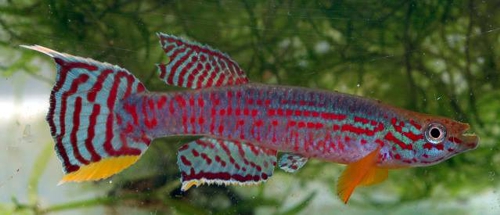

A.campomaanense. Photo courtesy of Jean-François Agnése
| Meaning of Name |
After the Campo-Maan Nature Reserve. |
||
| First Description |
Genetic characterization of the Aphyosemion
calliurum species group and description of a new species
from this assemblage: A.campomaanense
(Cyprinodontiformes: Aplocheiloidei: Nothobranchiidae)
from Southern Cameroon. Zootaxa 2045: 43–59 (2009) |
||
| Size | |||
| Meristics | |||
| Karyotype | |||
| Sub-Genus |
|
||
| Group |
calliurum |
||
| Synonyms |
|
||
Populations
|
|
||
| Type Locality |
ABC 06 / 84. Campo-Maán National Park. |
||
| Distribution | |||
| Habitat |
|
||
| Distinguishing Characteristics | Caudal fin has vertical red lines with a lower outer marginal band of yellow. Some specimens may show this yellow outer margin in the upper caudal fin as well. Anal fin has an outer margin of yellow/white with a thicker red submarginal band. | ||
| Colour/Pattern Variability | |||
| History | |||
| Breeding Notes |
Colin McCourt in BKA newsletter No. 539, Nov/December
2010 wrote a report - He used an 18 x 12 x 12" tank with 3 males
& 4 females. Four dark green floating mops, a piece of bogwood &
a large clump of Java moss was added. Salvinia
was used as a floating plant. Tank was filled to 75%. Water was pH 6·4-6·6,
TDS 22 (just over 1°KH), temperature 74°F. A small stocking
bag of peat was added. |
||
| Diameter of Egg | Reportedly small. | ||
| Remarks |
From the ABK numbers collected ABK 07/181 is the one which was distributed. Not sure about the others. |